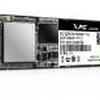ADATA launched the SX7000 SSD. The SX7000 uses an M.2 2280 form factor and 3D TLC NAND Flash, paired with an SMI controller. The SX7000 interfaces via PCI Express 3.0 x4 and meets NVMe 1.2 specifications to deliver 1800MB/s read, 850MB/s write, and 130K/140K IOPS.
The SX7000 is available in 128GB, 256GB, 512GB, and 1TB, making the most of the flexibility of 3D NAND to present consumers with greater choice based on budget and need.
The SX7000 connects to desktop and notebook PCs via low profile M.2 2280 and channels data through four-lane PCI Express 3.0. It uses 3D TLC NAND, meticulously sorted to ADATA standards, making the SX7000 a more accessible first-time M.2 purchase for many users. With NVMe 1.2, the SX7000 represents a massive upgrade compared to SATA SSDs and hard drives. Read speeds go up to 1800MB/s while write performance reaches 850MB/s. Those equal roughly ten times HDD performance, and compare very favorably with the 500MB/s read/write of SATA SSDs. Read and write IOPS figures are also at least 40% higher than SATA SSDs. The SX7000 is ideal as a fast boot/OS drive for first time buyers, cutting down boot delays to a few seconds. As a storage drive it offers significantly lower loading times in games and other applications.
All the benefits of 3D NAND in a low profile, efficient drive
M.2 SSDs not only exceed SATA drives in performance, they are also vastly more power efficient and take up far less space in desktops. For notebooks, they offer the benefit of reduced battery drain and thus longer battery life. The 3D NAND ADATA uses on the SX7000 is more reliable, faster performing, and longer lasting than 2D NAND. The SX7000 has a strictly-verified and stress-tested MTBF (mean time between failures) figure of 2 million hours, 25% more than 2D NAND drives.
Complete suite of performance-boosting features
The SX7000 provides users the same advantages of ADATA firmware design offered by the SX8000. SLC Caching allows it to enter pseudo single-level cell mode (pSLC) for sustained speed during heavy data loads. DRAM Cache Buffer further helps maintain consistent throughput, while LDPC ECC (low density parity check error correction) prevents data corruption, and Data Shaping evenly distributes tasks across Flash cells to reduce premature wear. This complete feature and performance package is backed by a 5-year warranty.
ADATA Offers XPG SX7000 PCI Express 3.0 x4 M.2 2280 SSD


